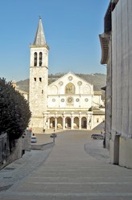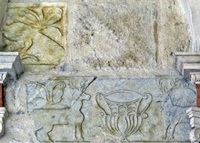Santa Maria del Vescovado
Architectural fragments (including those illustrated here, which are now embedded in the campanile, under the portico), which were re-used in the new construction, throw some light on the early history of the Duomo. They suggest the presence of a church here in the 6th century that was rebuilt in the 8th or 9th century, after the fall of the Lombard duchy.
The earliest documentary references to this church date to the 10th century:
-
✴In 956, Abbot Hildebrand of the Abbazia di Farfa, disposed of a parcel of land adjoining Abbazia di San Marco (a dependency of Farfa). The record of this transaction reveals that this land lay between the city wall and the property of "Sancta Maria Episcopii Spolitani", which confirms the existence of the Duomo on its present site at least from that time.
-
✴The monk John, who wrote the legend of St John of Spoleto in the reign of the Emperor Otto II (967-83), referred to the “ episcopatum Genitricis Domini nostri” (the bishop’s church dedicated to the Mother of Our Lord).
In 1067, Bishop Andrea II drew up a decree that instituted (or re-organised) the Cathedral Chapter and endowed the canons with a considerable patrimony. This included another parcel of land near the Duomo that extended as far as the parish church of Sant' Elia and the episcopal palace (old Palazzo Vescovile), which was built between the Duomo and the city walls.
This episcopal complex must have been badly damaged during the ravages of the Emperor Frederick I in 1155. His biographer refers specifically to the storming of the highest part of the city, "just opposite the principal church, the bishop's seat" which had seemed to be impregnable because of the slope of the mountain. He goes on to say that Frederick I left the city on the following morning because of the stench of fire and rotting corpses.
Spoleto had a series of schismatic bishops in the following two decades, none of whom left a mark on the city. Santa Maria del Vescovado and the episcopal palace therefore presumably remained in ruins. A resurgence of the city’s fortunes probably began in 1177 with the peace signed between Frederick I and Pope Alexander III and the investiture by the latter of Bishop Transarico. He seems to have moved to San Gregorio Maggiore in ca. 1178 so that the old episcopal palace could be demolished to make way for the new Duomo.
San Primiano (ca. 800)
The decree (1067) mentioned above also reveals that there was a structure near Santa Maria del Vescovato known as the "trivuna Sancti Primiani". This was probably the apse of what had been a church dedicated to St Primianus. In the early 20th century, Giuseppe Sordini discovered a structure under what is now the Cappella delle Reliquie that is generally accepted to be the crypt of this church. Excavation of the structure has revealed that San Primiano was probably built in the late 8th or early 9th century.
The crypt (which cannot be visited) is in the form of an annulus, almost certainly to facilitate access to the relics of a martyr, presumably those of St Primianus. Six frescoes (ca. 850) survive on the walls of the crypt from what was once a more extensive cycle: surviving inscriptions that refer to “Benedictus” and “Scholastica” confirm that the cycle comprised scenes from the life of St Benedict. This suggests that the church originally formed part of a Benedictine monastery.
This crypt was almost certainly under the apse of San Primiano, which suggests that this church was oriented at right angles to the present Duomo. The apse survived the re-modeling of the Duomo in the 15th century, by which time it was probably used by the canons and accessed directly from their cloister (to the left of the Duomo). It was demolished in 1540 to make way for the Cappella delle Reliquie in 1540.
There are at least two possible explanations for the fact that the nave of San Primiano had been destroyed by 1067:
-
✴there are signs that the surviving structure was damaged by fire at some point, perhaps during the Saracen raids that seem to have occurred in the early 10th century; and/or
-
✴the nave might have been demolished before 956 to make way for the construction or extension of Santa Maria del Vescovado (above).
Read more: There are two articles on San Primiano in G. Benazzi and G. Carbonara (Eds), “La Cattedrale di Spoleto: Storia, Arte, Conservazione”, Milan (2002):
✴C. Bozzoni and G. Carbonara, “La Cripta Carolingia e il Duomo Pre-Romanico”, pp. 74-9; and
✴M. Andaloro, “La Decorazione Pittorica della Cripta Altomedievale e l’ Aspettata Scoperta di un Ciclo di San Benedetto”, pp. 162-75.
Proceed to: Exterior; Interior.
Return to the home page on the Duomo.
Return to Monuments of Spoleto.
Return to Walk I.





